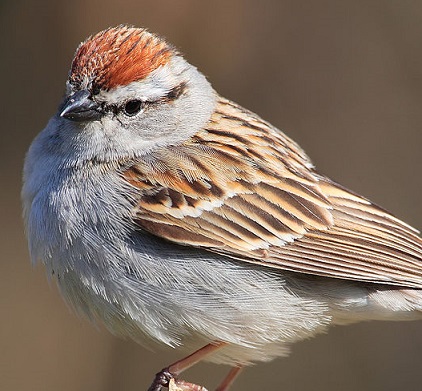Common Birds, Newsletters
Chipping Sparrow

The Chipping Sparrow is one of our more common native sparrows occurring across North America, but often one of the least recognized birds that we have in our yards each summer. These little birds are often mistaken for a Tree Sparrow which visits us in the Upper Midwest and Plains States during the winter months. But the “Chippies” have a shorter tail than the Tree or Song Sparrows and are just slightly larger than a Chickadee. Adults are 4.5″ to just under 6″ long weighing in at 0.4 to 0.6 ounces. But it is the rufous cap on top their striped heads that adds a dash of color making the adult birds fairly easy to recognize.
Chipping Sparrows are common around treed areas foraging in the open on the ground. You will find them in a variety of areas such as grassy forests, woodland edges, city parks, and tree lined backyards and in shrubbery. They seem to prefer nesting in evergreens when these trees are available but will also use deciduous trees. If you check the evergreens in your backyard you may be surprised to find a nesting pair.
The male arrives first in March or April and sets up his territory with the female following a week or so later. As with most songbirds, they migrate at night and can often be seen in flocks of thirty to fifty birds. Once the male has established his territory he begins to sing his trill song of chipping notes that resembles more of an insect. It is unmusical and seldom recognized by most of us. Their courtship is brief as they readily mate and begin nest construction.
Over a 3 to 4 day period the female will build a little grass nest which is extremely tidy from 3 to 10 feet above the ground. The male is often present guarding the female. Staying near he seems to cheer her on with much singing as she knits the grasses into a cup shape. She will then neatly line the interior with hair. They like black horse hair for some reason and if you check their nests you may find that she somehow came up with some. The completed nest measures about 4.5 inches across and 2 inches deep.
The female will lay from three to five pale bluish eggs which are spotted on the larger end. She will incubate the clutch of eggs for eleven to twelve days. After they hatch it will be another seven to ten days before the nestlings fledge from the nest.. They will fly clumsily around the branches for several days before gaining the confidence to venture out into the open. The parents will continue to feed these young birds for another three to four weeks. It is not uncommon for Chipping Sparrows to have two broods a season.
Chipping Sparrows primarily feed on the seeds of many grasses and herbs. They will also eat small fruits and berries. During the nesting season a large part of their diet consists of protein-rich insects which they will continue to feed on most the summer. During the summer the male Chipping Sparrow will defend his territory against other Chipping Sparrows yet tolerate other bird species as long as they do not get too near the nest. After the nesting season is over the Chippies will begin to form flocks of several dozen birds foraging together among the grasses or at bird feeders. This usually is in September as they go through their post nuptial molt and prepare for migration. On their spring return they will have a partial molt as the adults don their breeding plumage. The flight pattern of Chipping Sparrows is only slightly undulating and more of a straight, energetic flight.
Chipping Sparrows are a resident bird in the Southern U.S. and Central America. Those that breed in the upper latitudes of North America are short distant migrants wintering from Baja California through Mexico and into Florida. Their population remains healthy as they thrive in open tree filled spaces which are common landscapes in many backyards and parks.
So listen for the chipping insect like call of the Chipping Sparrow and you will soon recognize it everywhere. It’s petite size and tidy appearance will certainly make it one of your favorite backyard birds.
